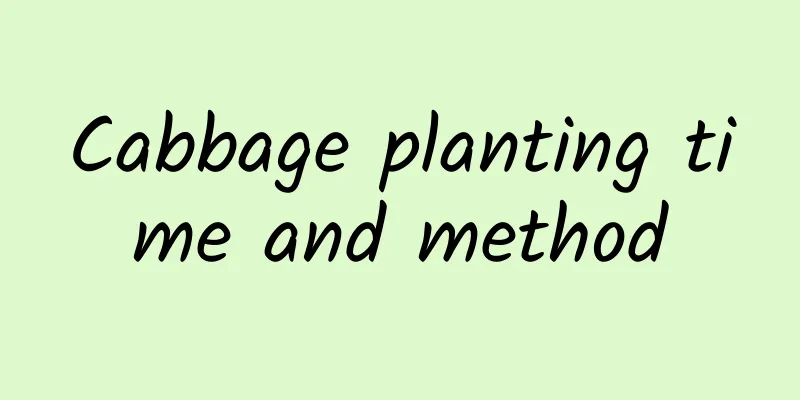Cabbage planting time and method

Cabbage growth habitsCabbage prefers a mild, humid and sunny environment. It is relatively cold-resistant and has the ability to adapt to high temperatures. The suitable growth temperature is between 15-20 degrees. The choice of soil is not very strict, but it is suitable for planting in clay loam or sandy loam with good drainage and rich humus. Cabbage planting timeCabbage has a strong adaptability to temperature and can be planted in the open field in spring, summer and autumn. In the cold northern regions, it can be sown and seedlinged in spring, and in the warm southern regions, it can be planted in spring and autumn. Cabbage planting methods and key points1. Land preparation Although the main root of cabbage is not well developed, it has many fibrous roots and is easy to take root. It is suitable for planting in loose and fertile soil with high organic matter content, good drainage and irrigation conditions. Apply sufficient base fertilizer and deep plowing and leveling the soil. 2. Planting Cabbage is suitable for planting in plots where no cruciferous crops were planted before. After deep plowing and fine harrowing, make 2-meter-wide beds and apply organic fertilizer and compound fertilizer. When the seedlings are 30-35 days old, they can be transplanted. The planting density is determined according to the variety. After transplanting, water the plants to keep them alive. 3. Seedling cultivation When raising cabbage seedlings, it is necessary to plow the land, dry the land, and prepare the land in advance. Pay attention to the scientific nature of land preparation to ensure that the width and height are 90 and 25 cm respectively, and the length is between 15 and 30 cm. The sowing time is from February to March. 4-5 days before sowing, a certain amount of manure, compound fertilizer, and wood ash must be applied, and they must be mixed evenly. 4. Field management Cabbage needs timely watering and fertilization. Topdressing is needed in the late rosette stage and early heart stage. Nitrogen fertilizer is mainly used in the early stage, and phosphorus and potassium fertilizers are added in the middle and late stages. Inter-row cultivation and weeding are also required. Watering should be reduced in the late stage of heading to avoid bulb cracking. 5. Pest and disease control In autumn and winter, the cabbage cultivated is seriously infested with pests, and attention should be paid to the prevention and control of pests such as aphids, cabbage worms, diamondback moths, cabbage armyworms, and cutworms. If the disease is relatively minor, no prevention and control is required. |
<<: Daylily planting time and method
>>: Time and method of planting four-season lettuce
Recommend
What are the cultivation methods and precautions of Hosta
How to grow Hosta Hosta is a perennial plant of t...
How many lucky bamboos are best to grow in soil? How to make lucky bamboos thicker in soil?
1. How many roots are best to grow? 1. Two roots:...
How long does it take for mountain rose cuttings to take root?
Mountain rose cutting rooting time When mountain ...
Does Gloxinia prefer shade or sun?
Does Gloxinia prefer shade or sun? Gloxinia is ea...
How to plant saffron bulbs
1. Prepare the soil When planting, do not choose ...
The difference between Amaryllis and Amaryllis
1. Different varieties Although Amaryllis looks s...
How to prune ivy
1. More resistant to shearing Pruning is very imp...
How to grow sunflowers
Sunflower Growing Conditions Sunflowers have a sh...
What to do if the leaves of Catharanthus roseus curl and wilt (What is the reason for the leaves curling and drooping)
Catharanthus roseus symbolizes happy memories and...
The efficacy and function of nail orchid
The efficacy and function of nail orchid The orna...
Why do succulent bulbs change color?
1. Lighting One of the main reasons why succulent...
What are the benefits of growing lilac at home?
The ornamental effect of lilac Lilac has a unique...
What are the differences between crabapple and sand apple?
Different families Crabapple is a plant of the Ro...
Cultivation methods and precautions of false leaf tree
Cultivation method of false leaf tree Pot soil se...
Cultivation methods and precautions of bird's nest fern
How to grow bird's nest fern Planting of Bird...









